As the gaze of the world fixes on London for tonight’s opening ceremony, Building looks back over the major events, turning points and chance encounters that helped to create the most extraordinary construction project the capital has ever seen
Tonight’s Olympic opening ceremony is set to be viewed by 4 billion people across the globe. It marks the culmination of seven years of incredible hard work, not just by the athletes set to take part, but by the organisers and the construction firms that have made the £9.3bn Games possible. Building has been covering the mammoth project since the moment International Olympics Committee president Jacques Rogge awarded the Games to London in 2005. Here we pull together the 12 key construction moments, without which tonight’s ceremony would not be taking place.
July 2005
Winning the bid, and the legacy promise
No one who was in Trafalgar Square on 6 July 2005, or saw the announcement on television, is likely to forget the eruption of joy that followed the awarding of the 2012 Olympics to the UK. It was a joy shared in the boardrooms of major UK construction firms: share prices soared on the day of the win. But then the harsh reality was felt by those who had come up with the £3.2bn bid. The decision was won on a promise to deliver regeneration - now that promise had to become reality.
In January 2004 masterplanner Edaw, now part of Aecom, had published its plans for the regeneration of the Lower Lea Valley to host the Games. Its planning permission promised 9,000 homes in the area - to rigorous environmental standards and half of them affordable - a raft of major new venues, 93,000ft2 of Olympic media facilities, and a new park for London. Renewal pledges made in the winning bid included the need to determine legacy uses before constructing many of the buildings, and a commitment to employ 9,000 staff, as well as putting money into training construction workers.
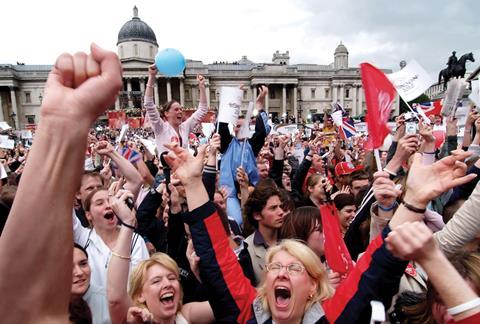
November 2005
David Higgins is appointed ODA boss

The appointment of David Higgins, the former chief executive of regeneration agency English Partnerships, was the most important - and best - early decision made by then Olympics minister Tessa Jowell. Tipped for the role from soon after the Games were awarded, the relaxed Australian had impressed in turning around English Partnerships from a virtual basket case to a smooth ship in less than three years, but it was his experience at Lend Lease working on the Sydney Olympics that was most relevant.
Higgins’ most important early call was in deciding to look again at the Olympic masterplan drafted by Edaw. He saw quickly that the expansive site planned by Edaw would only add to costs that were already being forced upwards. He ordered detailed design work to be put on hold while the masterplan was reworked by Edaw, along with partners Allies
& Morrison, Arup, Atkins, Buro Happold, Foreign Office Architects and HOK Sport.
The result, announced in June 2006, was a more compact site, with the media and broadcast centre moved from Stratford City to Hackney Wick, and the velodrome moved south of the A12. Although costs were still revised upwards, the increases would have been higher without the changes.
August 2006
CLM wins the delivery partner job
At 10am on Wednesday 30 August 2006, a consortium of construction firms was told it had won the biggest Olympic contract of them all - the role of 2012 delivery partner.
The team, known as CLM and comprising Laing O’Rourke, Mace and CH2M Hill, edged out US favourite Bechtel to clinch the deal - to “programme and project manage the whole procurement construction cycle, from design to post-2012 transformation”. The two other shortlisted consortiums to lose out were G3 (comprising Amec, Balfour Beatty and Jacobs) and Legacy (Bovis Lend Lease, Capita Symonds and KBR).
Then ODA chief executive David Higgins said at the time that the winning team “pairs the best of British industry with one of the world’s largest engineering firms”. And thanks to the performance delivery model of CLM’s contract and its success in hitting targets, the role has been massively lucrative. As of this month, CLM had netted £607m worth of fees from its partner, the Olympic Delivery Authority (ODA).
July 2007
Completion of the underground rerouting of the powerlines
On the face of it not the most eye-catching of milestones, but the tunnelling for the underground Olympic Park power cables was, in fact, the first Olympic construction project to be completed - and it was on time and on budget, as the ODA was at pains to point out.
Tunnelling work began on April 2006 and ended 15 months later with two 6km tunnels bored beneath the Olympic park to house the cables needed for the Games and the legacy developments. Four 40-tonne boring machines were used and around 350 workers completed the task - at the time one of the biggest tunnelling operations in the UK - in 424 days.
The project encountered a series of challenges, including issues with soil contamination, small ground movements and water ingresses beneath the surface of the Olympic park. More than 200,000m3 of spoil was created during the tunnelling process, enough to fill Wembley stadium. The vast majority was reused in the construction of the park. The completion of the project meant the 52 pylons that dominated the landscape could be removed, freeing the park for the construction of the main venues and infrastructure, which started the following year.
At the time, then mayor of London Ken Livingstone said: “This not only marks the completion of one of our first major projects on time and on budget but also the beginning of the transformation of east London.
“The area will benefit from new affordable homes delivered on a scale never seen before in the capital as well as thousands of new jobs that will come as we continue to regenerate the Lower Lea Valley in the coming decade.”
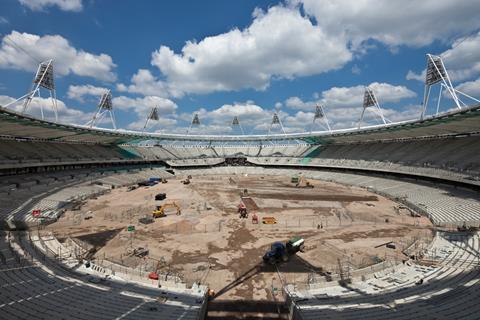
September 2007
John Armitt replaces Jack Lemley as ODA chair
The departure of the ODA’s first chairman Jack Lemley, in October 2006, sent shockwaves through the project. Lemley, an American civil engineer who had previously headed up the consortium that built the Channel Tunnel, had been seen as a safe pair of hands but left with a £388,000 payoff less than a year into the job.
Lemley later told his local newspaper back in Idaho that he quit because of the high chance that the project would go over budget and that it was too politicised.
Nevertheless, the loss of Lemley only proved a short-term problem for the project, especially after the arrival of the widely admired former Network Rail chief executive John Armitt. As the newly installed Armitt himself told Building in 2008: “Going through a difficult period with Jack has helped the board cement its own internal relations and has also helped us to think about what we should do if things are not working.”

May 2008
Venue construction starts
Above-ground construction on the Olympic park officially began when work got under way on the permanent foundations for the Olympic stadium - three months earlier than originally planned.
The first phase of construction involved reinforcing the ground on which the stadium was to sit by inserting around 4,000 concrete columns into the soil. This formed the permanent foundation for the stadium structure.
Through the autumn and winter of 2008, floor slabs were then laid for the base of the stadium “bowl” and the lower-tier structures, and columns that support the pedestrian concourse level were built. Early in 2009, the steel structures that support the stadium began to rise, giving an indication of its final height and scale.
The consortium involved in the stadium construction comprised contractor Sir Robert McAlpine, architect HOK Sport (now Populous), structural and building services engineer Buro Happold, landscape architect HED and planning consultant Savills Hepher Dixon.
At the ground breaking ceremony, the then prime minister Gordon Brown said: “I have no doubt that the construction of the new permanent venues, infrastructure and transport links within the largest new urban park to be created in Europe for 150 years will be a catalyst for lasting social and economic change in east London.”
Over the course of the stadium’s construction, over a thousand people worked on the venue.
January 2009
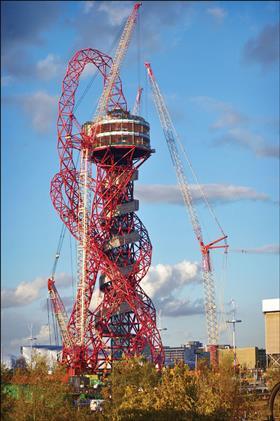
Boris Johnson meets Lakshmi Mittal in the cloakroom at Davos
Davos, Switzerland. The World Economic Forum annual meeting, 2009. The mayor of London. The chairman of the world’s largest steel conglomerate. A chance meeting in a cloakroom. No, this isn’t the espionage backdrop to a Bond thriller. It was actually the furtive conception of Europe’s tallest public art sculpture, the 115 m ArcelorMittal Orbit.
“We had a very friendly conversation that lasted approximately 45 seconds,” Boris Johnson later effused. “In that time I explained the idea and he said, ‘Great, I’ll give you the steel.”
It may come as little surprise to some that the idea for the £19.1m Orbit, designed by Anish Kapoor and Cecil Balmond, was conceived in a toilet. But one thing for which we and London’s skyline can probably be grateful is that they didn’t bump into Silvio Berlusconi in there too.
May 2009
The taxpayer bails out the athletes’ village
The government had initially hoped the private sector would step in and help fund certain key parts of the Olympic construction effort - particularly the £1.1bn athletes’ village. But the 2007 credit crunch changed everything. Early in 2008, it emerged that athletes’ village construction manager Lend Lease was struggling to raise private finance to fund its contribution to the project, reported to be around £450m of the total cost.
By the end of 2008, Olympics minister Tessa Jowell and the high-powered House of Commons Public Accounts Committee had both acknowledged that the public sector might be required to foot the total bill of the athletes’ village to save it.
Lend Lease did come up with a £375m package of financing - made up of £150m in equity and £225m of bank debt - but this was rejected by the government on the grounds that a privately funded package was too risky given the depressed market.
In hindsight it looks like Lend Lease made a lucky escape. The government sold the athletes’ village for a combined value of £825m - to Triathlon Homes and a Qatari Diar/Delancey joint venture - meaning the development as a whole made a loss of around £275m. In the end it’s the taxpayer who will foot the entire shortfall, not Lend Lease.
November 2009
Completion of roof lift at the aquatics centre
In the words of ODA chairman David Higgins himself, the lifting of aquatics centre roof was one of the “toughest construction and engineering challenges on the Olympic park”.
It is easy to see why. The almost 3,000 tonne wave-like structure rests on only three concrete supports. Fabricated and rolled in Newport and Gateshead respectively, the giant 160 x 90m roof truss frame was assembled on site on 20m high temporary support trestles. It was then precariously lifted and lowered onto its permanent supports thus enabling the removal of the temporary trestles.
While undoubtedly a magnificent feat of engineering, it could be argued all this effort was a little misplaced since Hadid’s core concept of a “floating” roof was subsequently utterly obscured by the two temporary seating stands beside it. Moreover, such column-free structural ambition always comes at a price: there is more steel in the aquatics centre roof than in the entire structural frame of the 41-storey Gherkin.
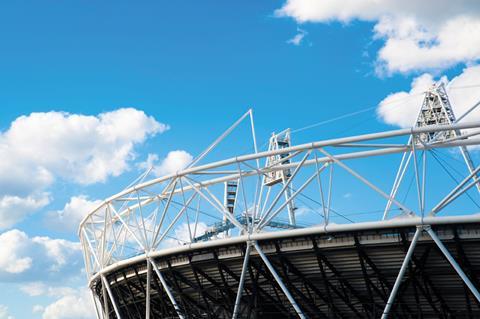
September 2010
Dennis Hone replaces David Higgins
Compared with the Lemley saga, the departure of ODA chief executive David Higgins in the autumn of 2010 caused far fewer ripples. When Higgins made the shock announcement that he was leaving to take up the role of chief executive of Network Rail - ironically the position John Armitt had held before he joined the ODA - it came at a much more stable time in the Olympic programme. As Armitt, who gave the move his blessing, said at the time: “David set up the ODA from scratch and leaves it with the project on time, within budget and on the verge of completing the first major venues on the Olympic park.”
This time, the ODA also had a ready replacement in Dennis Hone who had served as Higgins’ deputy at English Partnerships. By the time he took the helm, Hone had the experience necessary for the job, having served as director of finance and corporate services at the ODA for more than four years.
February 2011
Completion of the first venue - the velodrome
The sinuous, sculpted curves of Hopkins Architects’ velodrome now form an instantly recognisable silhouette on the east London skyline and can arguably lay claim to being London 2012’s best piece of architecture. But when it first opened on a freezing February morning last year, what it principally offered was an enticing glimpse of the future look of the Olympic park.
It also represented a key construction and publicity milestone. Whereas the Olympic budget has famously fluctuated, its adherence to programme has been impeccable. And the achievement was all the more impressive in the context of the problems that historically affect Olympic build programmes. At Montreal 1976 labour disputes prompted workers to secretly dismantle at night what their colleagues had built in the day. At Athens in 2004 contractors were still frantically applying “finishing touches” the night before the opening ceremony.
The completion of the Olympic stadium, in March the same year, also provided an opportunity for another more sobering reflection: the 2012 stadium is the only stadium of the modern Olympiad on which nobody died during construction.
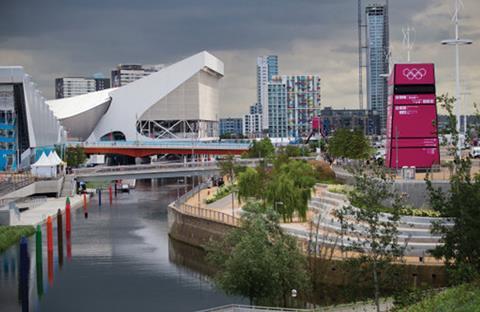
January 2012
Final ODA handover of built venues
After the initial hoopla of winning the bid, the collective crisis of confidence in the construction industry that followed, and seven long years of hard work, the Games venues were handed over on time and on budget in January. The handover of the Olympic park - complete with all the main venues - on 9 January and the athletes’ village on 27 January capped off a brilliant achievement for the UK construction industry.
The journey was not without its hurdles however, and the ODA overcame major issues to get over the line. The athletes’ village in particular proved challenging from the start. In addition to the funding problems, the project also underwent the upheaval of a change of contractor midway through, after Lend Lease subcontracted out half the plots to other contractors including Galliford Try, Sisk and P Elliott. Several firms went bust on the project, including P Elliott and subcontractors United AG and Trent Concrete, while Galliford Try became embroiled in legal wranglings with some of its subcontractors on the final two plots of the village.
While these issues affected the ODA’s construction schedule, handover to LOCOG was nevertheless achieved on time.




























No comments yet